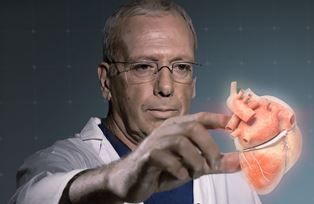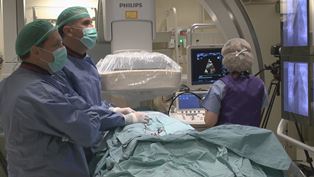Free-floating 3D holograms of heart used to guide heart surgery
31 October 2013
Royal Philips and RealView Imaging Ltd have completed a pilot study that has demonstrated the feasibility of using a live 3D hologram with interactive technology to guide minimally-invasive heart surgery.
The pilot study was conducted in collaboration with the Schneider Children’s Medical Center in Petach Tikva, Israel. RealView’s visualization technology was used to display interactive, real-time 3D holographic images acquired by Philips’ interventional X-ray and cardiac ultrasound systems.

Manipulating the holographic image. Source: RealView
In addition to viewing the patient’s heart on a 2D screen, doctors in the interventional team were able to view detailed dynamic 3D holographic images of the heart ’floating in free space’ during a minimally-invasive structural heart disease procedure, without using special eyewear.
The doctors were also able to manipulate the projected 3D heart structures by literally touching the holographic volumes in front of them. The study demonstrated the potential of the technology to enhance the context and guidance of structural heart repairs.

“The holographic projections enabled me to intuitively understand and interrogate the 3D spatial anatomy of the patient’s heart, as well as to navigate and appreciate the device-tissue interaction during the procedure,” said Dr. Einat Birk, pediatric cardiologist and Director of the Institute of Pediatric Cardiology at Schneider Children’s Medical Center.
Dr. Elchanan Bruckheimer, pediatric cardiologist and Director of the Cardiac Catheterization Laboratories at Schneider Children’s Medical Center, added: “The ability to reach into the image and apply markings on the soft tissue anatomy in the X-ray and 3D ultrasound images would be extremely useful for guidance of these complex procedures.”
“Our ultimate goal is to create the future of healthcare by delivering innovative solutions that enhance clinical capabilities and improve patient outcomes,” said Bert van Meurs, General Manager of Integrated Clinical Solutions and Marketing for Imaging Systems at Philips Healthcare. “By teaming up with partners that share our passion for innovation, we have been able to demonstrate the feasibility and potential value of the world’s first holographic visualization technology targeted at guiding minimally invasive cardiac procedures.”
“I see clear indications that 3D medical holography will play an important role in medical imaging in the near future,” said Aviad Kaufman, CEO of RealView Imaging Ltd. “With the advancement of live 3D imaging and increasing clinical evidence of its value for a variety of procedures, we are convinced that our holographic technology will further enhance 3D imaging and, most importantly, improve patient care.”
Progress in image-guided therapies for heart diseases — from the opening of obstructed coronary arteries to catheter ablation therapy for heart arrhythmias and catheter-based structural heart repairs (for example, heart valve replacements) — have greatly increased the need for live 3D image guidance, to supplement today’s live 2D image guidance.
Live X-ray and live 3D cardiac ultrasound imaging are typically used simultaneously to guide minimally invasive structural heart repair procedures, with the ultrasound images providing detailed insights into the heart’s soft tissue anatomy, and the X-ray imaging providing visualization of catheters and heart implants.